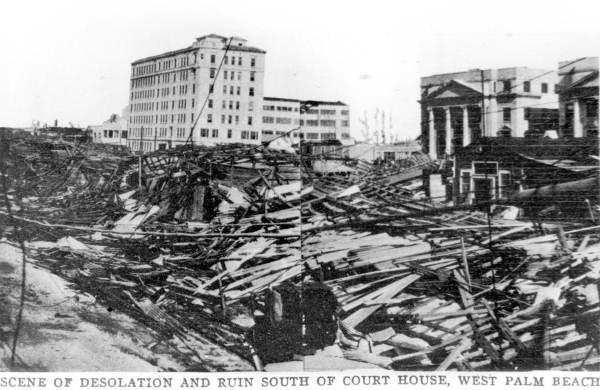 |
| The aftermath in West Palm Beach |
The Okeechobee
Hurricane or, in Puerto Rico, Hurricane San Felipe Segundo, occurred in
September of 1928. The hurricane made landfall in the Leeward Islands, Guadeloupe,
Puerto Rico, the Bahamas and the state of Florida. The Okeechobee Hurricane was
at different times a category three, four and five hurricane as it made its
destructive path through these locations. The damage caused by this hurricane
was at the time estimated to be one hundred million dollars. By today’s
standards that would be equal to one billion dollars. A total of 4,078 people
or more perished as a direct result of the storm.
The Okeechobee
Hurricane was first spotted 900 miles east of Guadeloupe on September 10, 1928.
Two days later, on September 12, the hurricane struck the island chain as a
category three. The storm caused around 1,200 deaths in Guadeloupe and major
property damage. The hurricane then hit the Leeward Islands causing 45 deaths.
The damage to crops and property was devastating.
The very next
day, the hurricane was at a category five when it made landfall in Puerto Rico.
Winds were reported around 160 miles an hour on the island. Around 36 hours
before the storm hit, the residents were warned of the danger. They were able
to prepare, so loss of life was comparably low with only 300 fatalities.
Hurricane Okeechobee was responsible for 50 million dollars (500 million
dollars today) worth of damage in Puerto Rico. Several hundred thousand people
on the island lost their homes.
The hurricane
then moved across the Bahamas as a category four. In the Bahamas, residents
were also prepared. There was not a single fatality on the island. Though, 18
people went missing when their sailboat was lost at sea. They are presumed
dead.
On September
16, Hurricane Okeechobee made landfall in the state of Florida as a category
four. The results were devastating. The eye of the storm passed over Palm Beach
County and went straight for Lake Okeechobee. Most of the damage sustained on
the Florida coast was in the area of Palm Beach, but loss of life in the area
was minimal. There were only 26 fatalities. The population near Lake Okeechobee
would not be nearly as lucky.
When the
hurricane finally hit Lake Okeechobee winds were around 140 miles per hour. As
the winds blew southward across the lake, a storm surge overflowed a dike on
its southern edge. This resulted in floods covering hundreds of square miles of
farming land and communities. A smaller flood on the northern part of the lake
occurred a little later, when the dikes there crumbled.
Many of the
bodies of the deceased were lost as floodwaters poured into the Everglades. The
floodwaters remained for some weeks, so it was very difficult for relief
workers to recover and bury the dead. Eventually mass graves were dug for the
bodies, but after a few days even that was not enough. The bodies began to
decay in the Florida sun, so survivors were forced to burn the dead.
All told,
2,500 people or more were killed in Florida that fateful day. Around 1,100 of
them were buried in one grave in the Port Mayaca Cemetery. The hurricane caused
25 million dollars(250 million dollars today) worth of property damage in
Florida.
After leaving
Lake Okeechobee, the hurricane moved northeast over Florida and into Georgia
and the Carolinas causing only minimal damage in these places. In the aftermath
of the hurricane, it became apparent to authorities that flood control on Lake
Okeechobee needed to be brought up to par. Building codes were also changed in
the hopes that future hurricanes would not cause such extensive damage.
Sources
Doup, Liz, 1928-Okeechobee,
Sun-Sentinel, September 11, 1988
Wikipedia, Okeechobee
Hurricane, retrieved 6/5/06, wikipedia.org/wiki/Okeechobee_Hurricane
No comments:
Post a Comment